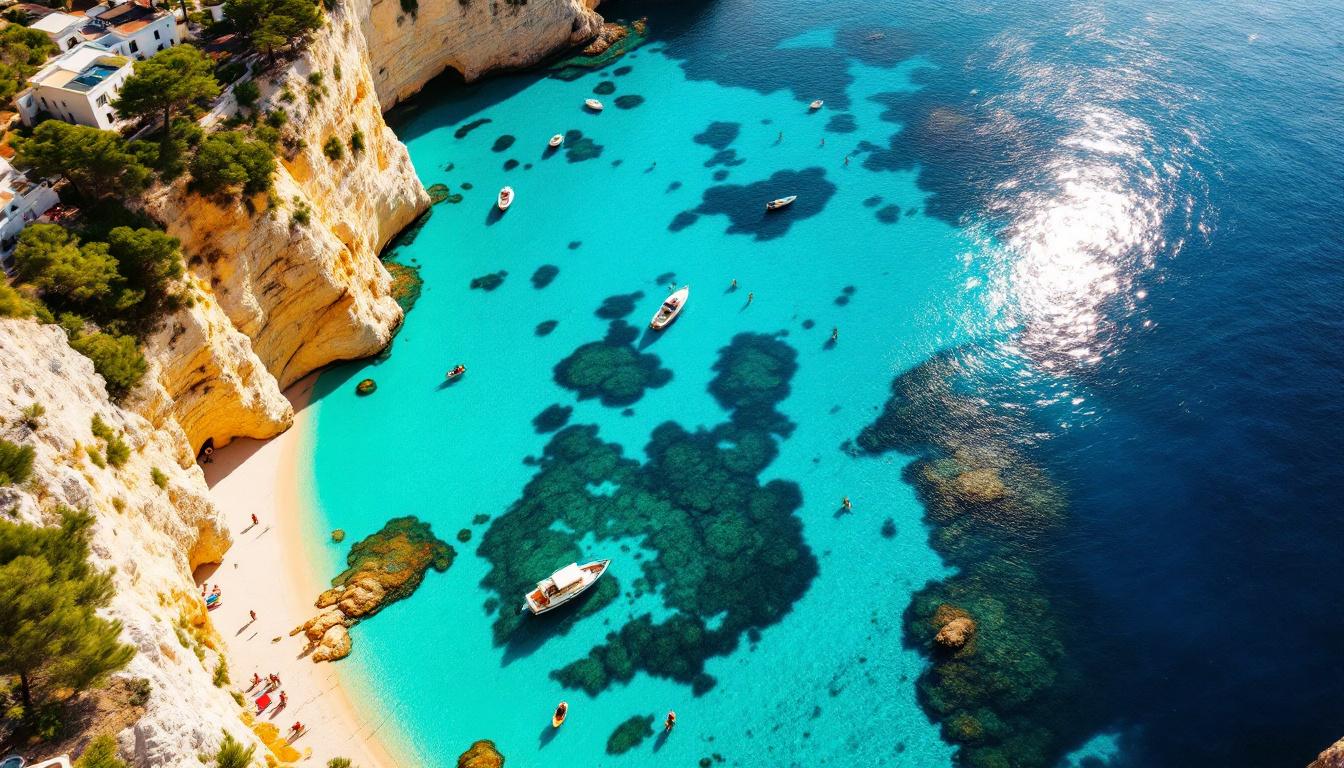Most travelers rush past Puglia’s Salento peninsula chasing Instagram shots of Positano’s crowded terraces. But tucked along this narrow finger of land stretching into the Adriatic lies something extraordinary: beaches so pristine that locals guard them like family secrets.
The Salento peninsula measures just 100 kilometers from tip to toe, yet harbors over a dozen hidden coves that rival any tropical paradise. Villages like Castro (population 2,500) and Santa Cesarea Terme (fewer than 3,000 residents) serve as gateways to beaches locals call “our Maldives” – a nickname that becomes crystal clear the moment you glimpse Pescoluse’s turquoise shallows.
While tour buses clog the Amalfi Coast’s single coastal road, these tiny Salento gems remain blissfully undiscovered by mass tourism. Here’s why this microscopic peninsula delivers oversized magic.
The lagoon that defies Mediterranean expectations
Pescoluse creates tropical illusions in southern Italy
Stretching 5 kilometers along the Ionian coast, Pescoluse beach earned its “Maldives of Salento” nickname through an extraordinary geological accident. High carbonate content in the limestone bedrock filters seawater into impossible shades of turquoise and emerald. The sand, bleached white by centuries of Mediterranean sun, creates color contrasts that photographers struggle to capture without saturation.
Porto Selvaggio hides behind protective pine forests
This tiny protected cove requires a 20-minute hike through ancient pine forests, filtering out casual tourists. The reward: a pebbled beach enclosed by 40-meter limestone cliffs that create perfect swimming conditions even when winds batter the open coast. Local families arrive at dawn carrying espresso thermoses, claiming their favorite rocks like reserved theater seats.
Secret access routes locals prefer you discover slowly
Sant’Andrea’s hidden coves demand boat navigation
Near Monopoli, the coastline fractures into a dozen tiny inlets accessible only by boat or serious rock climbing. Local fishermen offer informal tours for €25 per person, guiding visitors through sea caves and natural arches that remain invisible from land. These boat captains speak in Pugliese dialect, sharing stories their grandfathers told about pirates and hidden treasures.
Porto Cesareo’s marine reserve protects underwater meadows
This protected area encompasses 16,000 hectares of pristine Mediterranean seabed, where Posidonia grass meadows create oxygen-rich swimming conditions. Snorkeling reveals fish populations that disappeared from busier coastlines decades ago. The town imposes strict visitor limits during peak season, ensuring beach experiences remain intimate rather than industrial.
Village life that tourism hasn’t transformed
Castro’s morning fish markets operate on ancient rhythms
In Castro’s tiny harbor, fishing boats return each morning at 6 AM with the night’s catch. Local women arrive with plastic bags and negotiating skills honed over generations, selecting sea urchins and fresh anchovies while tourists sleep. The entire transaction concludes by 7:30 AM, preserving authentic community rituals unchanged for centuries.
Santa Cesarea Terme maintains thermal spring traditions
This clifftop village built around natural hot springs attracts Italian families seeking traditional wellness treatments. Four thermal springs maintain constant 30°C temperatures year-round, creating spa experiences rooted in local mineral content rather than imported luxury concepts. Grandmothers bring grandchildren for traditional treatments, continuing family traditions stretching back generations.
The cost advantages that protect authentic experiences
Accommodation prices remain refreshingly reasonable
While Amalfi Coast hotels demand €300-500 nightly during summer, Salento’s agriturismos and small hotels charge €80-150 for comparable oceanview rooms. Family-run establishments serve homemade orecchiette and local Primitivo wine, creating intimate dining experiences impossible in overtouristed destinations. These lower costs naturally limit visitor numbers to sustainable levels.
Restaurant meals celebrate local ingredients over tourist expectations
A complete seafood dinner in Castro or Gallipoli costs €25-35 per person including local wine, featuring catch-of-the-day preparations unchanged for decades. Compare this to €60-80 for similar meals along the Amalfi Coast, where restaurants cater to cruise ship schedules rather than seasonal rhythms.
The Salento peninsula proves that Italy’s most enchanting coastal experiences hide in plain sight, protected by their own intimate scale. While Instagram influences chase Capri’s crowds, this tiny corner of Puglia rewards patient travelers with authentic Mediterranean magic.
Visit during September or early October for perfect swimming conditions and genuine local atmosphere. The beaches will still be there – unchanged and uncompromised, just as locals prefer.
